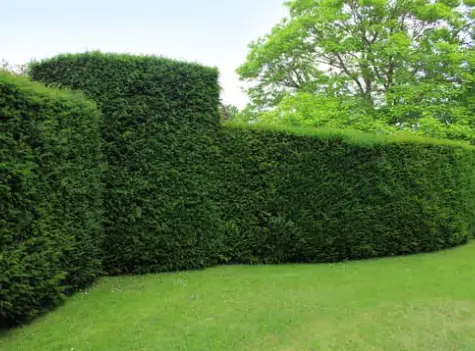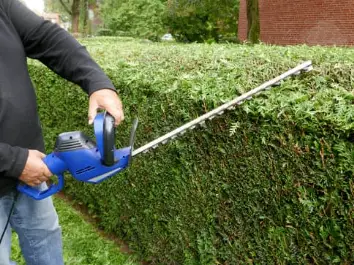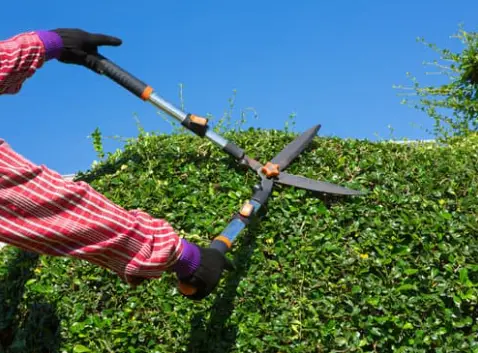Hedges are an essential part of any garden or landscape. They provide privacy and security while offering sound insulation benefits. A well-maintained hedge not only looks great but is also beneficial to the environment by providing a habitat for birds and insects. Regular pruning, cutting, and trimming of hedges are crucial in maintaining healthy hedges and encouraging green growth.
When done correctly, pruning helps improve airflow throughout the hedge while promoting new, thicker, and denser growth. This allows hedges and leading shoots to stay healthier for longer.
Equipment Girl is on hand to ensure you have all the information you need to prune hedges effectively with hedge trimmers.
The Benefits Of Maintaining Healthy Hedges
There are many benefits to maintaining hedges in great condition, including:
- Enhances the overall aesthetic appeal of your garden
- Creates a consistent look throughout your landscape design
- Provides privacy without compromising on natural light or obstructing views like walls
- Reduces noise pollution from busy streets by acting as sound barriers
- Provides habitats for small mammals like squirrels
- Offers food sources to birds, such as berries, increasing biodiversity in gardens
With so many benefits on offer, it is easy to see why maintaining your hedges is a crucial task.

Different Types Of Hedges Require Specialist Care
Different types of hedges have additional requirements when it comes to pruning tools. Some may require hand-held shears, while others need electric trimmers for best results. Choosing the right tool for your particular type of hedge is essential.
For example, formal or geometric-shaped evergreen hedges such as boxwood or yew need sharp hand-held shears with straight blades to achieve a precise finish on topiary forms or shapes such as spheres or cones with clean lines.
Alternatively, informal evergreen or deciduous branches like rose bushes or a Hawthorn hedge will respond well to formative pruning and techniques like shearing with electric hedge trimmers since they do not need precision shaping.
What Are Formal Hedges, And How Do They Differ From Informal Hedges?
Formal hedges and informal hedges are two distinct styles of hedge design.
A formal hedge is characterised by its precise and geometric shapes, in uniform heights and widths, with straight lines and well-defined edges. Formal hedges often require regular maintenance to maintain their clean and polished appearance.
On the other hand, an informal hedge has a more natural and relaxed appearance. They are often allowed to grow more freely, with a less structured shape and varied heights. Informal hedges may have curved or irregular outlines, giving them a more organic and casual look. They require less frequent pruning and often contain flowering shrubs like roses or lavender.
The choice between formal and informal hedges depends on personal preference, the desired aesthetic, and the intended function of the hedge within the landscape design.

Characteristics And Growth Habits
Understanding the characteristics and growth habits unique to each type of hedge is also essential before you begin pruning work on them. Evergreens tend to grow slower than stocky deciduous plants; hence, they don’t need constant attention except for regular hedge trimming sessions, while deciduous hedges grow rapidly, so it is important to prune them frequently and at the right time of year.
It’s also important to know how much pruning hedges can tolerate.
For instance, boxwood is a slow-growing shrub that can’t withstand too much pruning simultaneously. In contrast, conifer hedges or a beech hedges are fast-growing and can handle more aggressive pruning if done correctly.
Choosing The Right Tools For Each Type
For example, hand-held shears and light hedge trimmers are essential for formative pruning on small evergreen shrubs like boxwood and arborvitae. In contrast, a powered hedge trimmer works best on tall hedges like evergreens or deciduous varieties such as beech hedges, privet, or hornbeam hedging. For more information check out our post “Best Tool For Cutting Hedges“.
Make Sure You Maintain Your Hedge Trimmer
Investing in quality tools with appropriate blades that are sharp and well-maintained will make your hedge-trimming work more manageable and less time-consuming in the long term. To learn more about how the best hedge trimmer brands, take a look at our post.

When To Prune Hedges
Pruning hedges at the right time is essential for their healthy growth and appearance. The timing of pruning depends on the type of hedge you have, its growth habit, and its purpose.
Pruning at the wrong time can result in weak growth, diseases, and even death. Therefore, knowing when to prune your hedge, and when to delay trimming is essential, as is how often.
Best Time To Prune Different Types of Hedges
It is best to prune deciduous hedges at the end of winter or early spring before new growth appears. Examples of deciduous hedges include beech, hornbeam, and privet.
After their growth has emerged, late spring or early summer is the best time to prune evergreen hedges. Examples of evergreen hedges include boxwood, yew, and laurel.
Prune flowering hedges after they have bloomed to avoid cutting off next year’s flower buds. Examples of flowering hedges include lilac and forsythia.
Some hedges require more than one yearly pruning to maintain their shape or size.

Factors To Consider Before Pruning
Before you start pruning your hedge, there are certain factors that you should consider to ensure its success. One factor is the age of your hedge; young plants need less pruning than older ones.
Another factor is the purpose of your hedge; if it’s a privacy screen or windbreaks that don’t require shaping like topiary forms, then prune only when necessary for maintenance purposes.
It would be best to consider your plants’ health condition; deadwood can be removed throughout the year, while it is vital to remove diseased branches immediately before they spread any further damage throughout the plant.
Weather conditions can impact the timing of pruning; avoid trimming when it’s hot or dry, as this can cause the foliage to dry out and become damaged. For more information check out our post “Why Tree Pruning Is Important“.
Tools For Pruning Hedges
To keep your hedge healthy and beautiful, you’ll need the right tools. Essential tools for hedge pruning and trimming include:
- Hand shears for precise shaping and intricate designs
- Electric hedge trimmers or hedge cutters for larger hedges and a uniform shape
- Loppers for thicker branch pruning
- Pruning saws for cutting thick stems
- Pruning knives or secateurs, with anvil-type for dead wood and bypass-type for live branches
Additionally, you should use a ladder for tall hedges.
Step-by-Step Guide On How To Prune Hedges
Pruning a hedge may seem intimidating at first but it is actually quite simple once you get the hang of it, and formative pruning is easier than you might think.
- Start by inspecting the overgrown hedge and remove any dead or damaged branches using loppers or pruning saws.
- Use hand pruners to remove small twigs or shoots growing from the main stem.
- To achieve an even height, set up string lines tightly between two stakes as a straight-line guide for your shears or electric trimmer. Trim from one end, working your way down, ensuring both sides are level.
- For advanced topiary shapes like spirals, wrap the wire around the trunk in a spiral pattern before pruning away excess foliage. For ball topiaries, shape the hedge into a sphere, and for pyramid topiaries, prune the sides at an angle to create a triangular shape.
- When creating topiary shapes, use sharp pruners or shears, and make precise cuts. Regular maintenance trimming is essential to create a shape you adore, especially with a tall hedge.
- To cut straight lines with established hedges, use a string line by tying it tightly between two nails positioned parallel to the hedge’s surface. Alternatively, use a level vertically against the hedge’s edge for more precision. The level will help maintain precisely and even cuts throughout the process.
- Remember to take your time, use the appropriate tools, and prioritise precision for a well-maintained and visually appealing finish when hedge cutting.
This form of rejuvenation pruning can transform upright plants, thicker branches, and broad-leaved evergreens. Don’t also miss our article on Best Hedge Trimmers For Thick Branches – it offer valuable insights into this important topic.

Tips On How To Use Hand Shears And An Electric Hedge Trimmer
You have two main options when trimming hedges: shears and trimmers. Hand shears are great for precise trimming, shaping edges, and removing individual branches but require more time and effort. Electric trimmers are faster for shaping large areas but offer less precision.
When using trimmers, be cautious to avoid damaging foliage and keep the blade at a proper distance from the hedge surface. Remember to keep your chosen tool clean and well-maintained for the best maintenance trimming results. You can check out our post “What Is A Hedge Trimmer?” for more additional insights.
Common Mistakes When Pruning Hedges
When pruning hedges, beginners should be aware of common mistakes. One mistake is cutting too much at once, which can damage the hedge irreversibly. Avoid this by removing at most a third of the growth. Another mistake is to cut correctly at the base of each stem or branch, leading to uneven development.
How To Avoid Damage When Hedge Cutting
Proper pruning is essential for a healthy and attractive hedge while avoiding mistakes that can damage its appearance. Ensure your tools are sharp and clean to make clean cuts instead of crushing or tearing branches. Consider the placement of overgrown branches before cutting them back to maintain balance and future growth.
Maintenance Trimming Offers Tremendous Results
Maintaining healthy hedges is essential for aesthetic purposes and the overall health of your garden. Pruning, cutting, and trimming may seem intimidating, especially for beginners, but it can be an enjoyable and rewarding experience with the right tools and techniques.
Remember to choose the right time to prune your hedges based on their type and growth pattern. Use essential tools such as loppers or trimmers and adequately care for them by cleaning and sharpening them regularly. We also recommend taking a look at our post “How To Sharpen A Hedge Trimmer” for valuable insights.
Tip To Consider On How To Cut Hedges
Here are some tips to keep in consideration when you prune and cut hedges:
- Regularly check for any signs of pests or diseases on your hedge
- Look out for nesting birds before cutting hedges
- Always use a hedge trimmer or hedge clippers with sharp blades when pruning
- Clean up after pruning by removing all debris from around the hedge area
- Water your hedge consistently during dry periods
Consider hiring professional help if you’re unsure about how to handle any situation while maintaining hedges.
Frequently Asked Questions
During Which Months Is It Recommended To Trim Hedges?
The recommended months to trim hedges depend on the type of hedge you have. For most hedges, it is best to trim them during the dormant season, which is typically in late winter or early spring.
Trimming during this time allows the hedge to recover and promote healthy growth during the active growing season.
When Starting To Trim Hedges, Should You Begin With The Top Or The Sides?
When trimming overgrown hedges, it is generally advisable, to begin with the sides rather than the top of the hedge. Trimming the sides first helps establish the desired shape and maintains a uniform appearance.
By focusing on the sides initially, you can create a solid foundation and then shape the top of the hedge accordingly.
Is It Appropriate To Trim Your Neighbour’s Side Of The Hedge?
Trimming your neighbour’s side of boundary hedges is generally inappropriate without their consent. Property boundaries and shared hedges can be sensitive issues, and it’s essential to communicate and respect your neighbour’s preferences.
Before trimming any part of the hedge that borders your neighbour’s property, it is best to have a conversation with them to reach a mutually agreeable solution.
In General, Should Hedges Be Wider At The Top Or At The Bottom?
Generally, hedges should be slightly wider at the bottom and narrower at the top of the hedge. This shape allows sunlight to reach the lower branches, promoting healthier growth throughout the hedge.
The broader base provides a stable foundation, while the tapered top prevents excessive shading and encourages a neat and aesthetically pleasing appearance.

